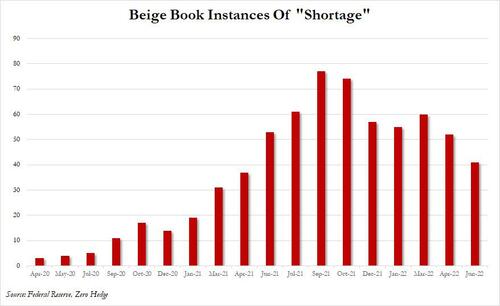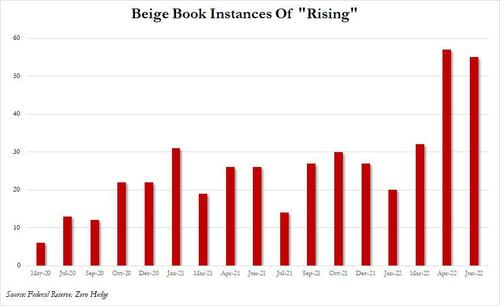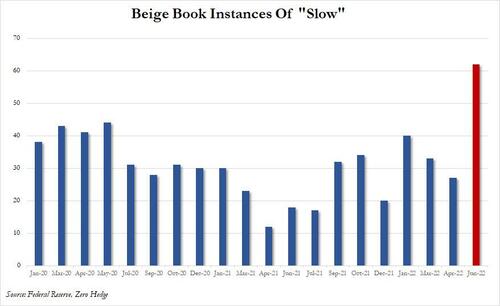Beige Book Shows Fed Quietly Freaking Out About Widespread Economic Slowdown
A little over a month after the Fed’s April Beige Book found that the US economy was growing at a “moderate pace”, and spotted the first instances of demand destruction and slowing wage growth, things have gone from medicore at best to simply dire.
Not that one would necessarily get that sense reading the summary of overall economic activity which was relatively cheerful, with the Fed noting that all twelve Federal Reserve Districts reported “continued economic growth since the prior Beige Book period, with a majority indicating slight or modest growth” and four Districts indicated moderate growth. To be sure, it is notable that the Fed admitted that four Districts explicitly noted that the pace of growth had slowed since the prior period, even as contacts in most Districts reported ongoing growth in manufacturing.
On the other hand, a glimpse of the real underlying weakness emerged when the Fed warned that “some softening as consumers faced higher prices, and residential real estate contacts observed weakness as buyers faced high prices and rising interest rates.” Still, contacts tended to cite “labor market difficulties as their greatest challenge, followed by supply chain disruptions” in other words, the covid/China legacy bottlenecks remain, even though soaring inflation is finally destroying the most demand in years. And indeed, “rising interest rates, general inflation, the Russian invasion of Ukraine, and disruptions from COVID-19 cases (especially in the Northeast) round out the key concerns impacting household and business plans.”
Most ominous of all, whereas eight Districts reported that expectations of future growth among their contacts had diminished; “contacts in three Districts specifically expressed concerns about a recession.” And if the Fed will state that publicly, it means that all 12 Fed districts are starting to freak out.
Some more details from the reports, starting with Labor Markets
- Most Districts reported that employment rose modestly or moderately in a labor market that all Districts described as tight.
- One District explicitly reported that the pace of job growth had slowed, but some firms in most of the coastal Districts noted hiring freezes or other signs that market tightness had begun to ease.
- However, worker shortages continued to force many firms to operate below capacity. In response, firms continued to deploy automation, offer greater job flexibility, and raise wages.
- In a majority of Districts, firms reported strong wage growth, whereas most others reported moderate growth.
- However, in a few Districts, firms noted that wage rate increases were leveling off or edging down.
- Moreover, while firms throughout the country generally anticipate wages to rise further over the next year, one District indicated that its firms’ expected rate of wage growth has fallen for two consecutive quarters.
And moving on to prices, where demand destruction is starting to really ramp up:
- Most Districts noted that their contacts had reported strong or robust price increases – especially for input prices.
- Two Districts noted that this rapid inflation was a continuation of trend; however, three Districts observed that price increases for their own goods or services had moderated somewhat – across the board (among Philadelphia firms) or for some segments (used cars in Boston and manufacturing in Richmond).
- About half of the Districts observed that many contacts maintained pricing power – passing costs on to clients and consumers, often with fuel surcharges. However, more than half of the Districts cited some customer pushback, such as smaller volume purchases or substitution of less expensive brands.
- Surveys in two Districts pegged year-ahead increases of their selling prices as ranging from 4 to 5 percent; moreover, one District noted that its firms’ price expectations have edged down for two consecutive quarters.
Elsewhere, several months of improvement (i.e. reduction) in mentions of shortages, recall that the March Beige Book saw a modest deterioration, with “mentions” of shortage rising from 55 in January to 60 in March. Well, in April the word “shortage” was used just 52 times, the fewest since April of 2021, and that number dropped again in June to just 41. It appears that supply-chains, at least from the Fed’s perspective, are no longer broken.
However, while the easing in shortages was more than offset by another month of sharply higher mentions of the word “rising”, which was used no less than 55 times, almost double the 32 times in March and just shy of the record 57 recorded last month – – usually in the context of prices or joblessness…
… it was a new word that caught our attention in June. As shown below, instances of the word “slow” and its variants exploded to 62, more than doubling from 27 in April, and surpassing the economic collapse levels observed in Q1 2022.
That’s right: while the Fed won’t openly admit it – after all doing so would be tantamount to losing all credibility and seeing stocks explode at a time when Biden is pressuring Powell to crash stocks and spark deflation – the central bank is openly freaking out about the coming recession. One just has to read between the lines, or rather the lines, to figure it out. We expect the broader market will do so shortly.
Source: Beige Book
Tyler Durden
Wed, 06/01/2022 – 14:57
via ZeroHedge News https://ift.tt/uO9NqDE Tyler Durden


